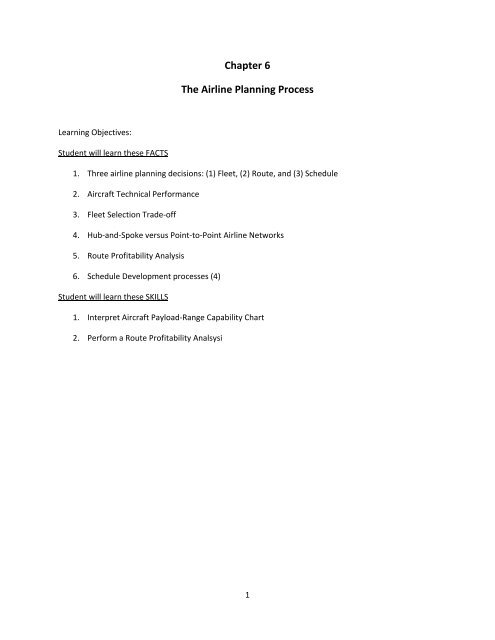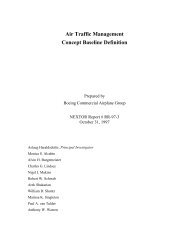Chap 6 Learning Objectives and Workbook
Chap 6 Learning Objectives and Workbook
Chap 6 Learning Objectives and Workbook
You also want an ePaper? Increase the reach of your titles
YUMPU automatically turns print PDFs into web optimized ePapers that Google loves.
<strong>Chap</strong>ter 6<br />
The Airline Planning Process<br />
<strong>Learning</strong> <strong>Objectives</strong>:<br />
Student will learn these FACTS<br />
1. Three airline planning decisions: (1) Fleet, (2) Route, <strong>and</strong> (3) Schedule<br />
2. Aircraft Technical Performance<br />
3. Fleet Selection Trade‐off<br />
4. Hub‐<strong>and</strong>‐Spoke versus Point‐to‐Point Airline Networks<br />
5. Route Profitability Analysis<br />
6. Schedule Development processes (4)<br />
Student will learn these SKILLS<br />
1. Interpret Aircraft Payload‐Range Capability Chart<br />
2. Perform a Route Profitability Analsysi<br />
1
<strong>Chap</strong>ter 6<br />
The Airline Planning Process<br />
1. Draw a Hierarchy Map of <strong>Chap</strong>ter 6<br />
Airline Planning Process<br />
Fleet Planning (6.1) Route Planning (6.2) Schedule<br />
Development (6.3)<br />
Integrated Airline<br />
Planning (6.4)<br />
2
2. Name <strong>and</strong> describe the three categories of airline planning decisions:<br />
Category<br />
1.<br />
Description<br />
2.<br />
3.<br />
3
FLEET PLANNING<br />
1. An airlines fleet is described by:<br />
a. ______________________________________________________________<br />
b. ______________________________________________________________<br />
2. The most important characteristic of technical performance of an airplane is:<br />
_______________________________________________________________________<br />
_______________________________________________________________________<br />
3. Decisions made by an airline to acquire new aircraft or retire aircraft in it’s fleet have direct<br />
impact on:<br />
a. _________________________________________________________<br />
b. _________________________________________________________<br />
c. _________________________________________________________<br />
4. In 2008 dollars the price of the following aircraft are:<br />
Aircraft Type<br />
Twin Engine, Narrow body, 150 seats,<br />
short/medium haul<br />
Long‐range, wide body, +400 seats<br />
Long‐range, wide‐body, +600 seats<br />
Price<br />
5. The typical life‐span of a commercial airplane is:<br />
_________________________________________________________________<br />
6. Why does the life‐span of a commercial airplane create difficulties for fleet planning. Explain.<br />
4
___________________________________________________________________________________<br />
____________________________________________________________________________________<br />
7. The major technical performance characteristics of an airplane are:<br />
Technical<br />
Performance<br />
Characteristic<br />
1.<br />
Description<br />
2.<br />
8. Figure 6‐1 (page 156) plots the size versus range capabilities of different commercial aircraft.<br />
a. Which part of the state‐space exhibits the most competition?<br />
___________________________________________________________________________<br />
b. What has happened to the range of the largest aircraft over time?<br />
___________________________________________________________________________<br />
5
10. What is “fleet commonality” <strong>and</strong> why is it important to the airlines?<br />
______________________________________________________________________________<br />
______________________________________________________________________________<br />
11. Figure 6‐2 (page 157) is the Payload‐Range curve for the B767‐300ER. The curve has 3 linear<br />
segments. What is traded‐off in each segment? Explain.<br />
______________________________________________________________________________<br />
______________________________________________________________________________<br />
______________________________________________________________________________<br />
______________________________________________________________________________<br />
6
NOTES ON RANGE<br />
Range is the maximum distance that an aircraft flies without refueling.<br />
Range is a tradeoff between distance <strong>and</strong> payload.<br />
Range is estimated using Breguet Range equations as follows:<br />
1. Additional distance flown (dR) is derived from the Velocity (V) over the<br />
incremental period of time (dt).<br />
dR = V * dt<br />
2. As aircraft flies it burns fuel <strong>and</strong> loses significant weight. The change in weight<br />
(dW) over time (dt) is a product of the Specific Fuel Consumption (SFC) <strong>and</strong> the<br />
Thrust (T) required to maintain constant velocity at Cruise Flightlevel<br />
dW/dt = SFC * T<br />
Notes on SFC:<br />
SFC = lbs/hr/lbf = pounds per hour per pound of force produced.<br />
Varies with altitude <strong>and</strong> speed.<br />
SFC for Pratt & Whitney engine 4806 on Boeing 777 at 0.8M at 11,000m = 0.6<br />
lb/hr/lbf.<br />
3. Specific Air Range (SAR) is a measure of the efficiency of an aircraft = ratio of<br />
distance flown per unit of fuel consumed<br />
dR/dW = V/SFC*T<br />
4. Breguet Range Equation:<br />
R = (V/SFC) (Lift/Drag)ln(Initial Weight at start of Cruise/Final Weight at end of<br />
Cruise<br />
How to derive Breguet: Start with SAR equation, replace Thrust with estimate<br />
based on Lift <strong>and</strong> Weights, integrate dR over weight range.<br />
NOTE: Range is a function of Weight<br />
7
Notes on Payload‐Range Diagrams<br />
MTOW = Maximum Take Off Weight<br />
Three corner points represent combinations of range <strong>and</strong> payload.<br />
• Point 1: aircraft carries its maximum load (i.e. departs with maximum takeoff gross<br />
weight). Corresponding range is limited.<br />
• Point 2: compromise between payload <strong>and</strong> range. Aircraft departs with full fuel load,<br />
but limits passenger <strong>and</strong> cargo weight to provide extended range.<br />
• Point 3: maximum range. Aircraft departs with full fuel load <strong>and</strong> no passengers or<br />
cargo. Typically a ferry/delivery mission.<br />
Limitations of Payload‐Range Diagrams applicable for only:<br />
• zero wind conditions<br />
• 0.84 Mach<br />
• St<strong>and</strong>ard day conditions (e.g. st<strong>and</strong>ard atmosphere)<br />
• Fuel reserves for additional 1.25 hours<br />
8
12. There two ways airlines acquire aircraft. Identify <strong>and</strong> describe the advantage/disadvantages of<br />
each one.<br />
______________________________________________________________________________<br />
______________________________________________________________________________<br />
13. When the airline purchases an aircraft, full payment to the manufacturer is required at time of<br />
aircraft delivery. Name 4 sources of capital.<br />
______________________________________________________________________________<br />
______________________________________________________________________________<br />
______________________________________________________________________________<br />
______________________________________________________________________________<br />
14. In addition to the purchase price, initial costs for a new aircraft include:<br />
______________________________________________________________________________<br />
______________________________________________________________________________<br />
9
______________________________________________________________________________<br />
______________________________________________________________________________<br />
15. Complete the table below to describe the tradeoff in purchasing a new aircraft (as opposed to<br />
using existing fleet)<br />
Advantages<br />
Dis‐advantages<br />
Appease political pressure<br />
10
ROUTE PLANNING<br />
The choice of aircraft <strong>and</strong> fleet plan determines the availability of the aircraft with different<br />
capacity <strong>and</strong> range characteristics. The next step in the airline planning process is to determine<br />
the specific routes to be flown.<br />
1. Economic considerations <strong>and</strong> expected route profitability determine the routes serviced by the<br />
airline. Route profitability estimates require forecasts of:<br />
a. _______________________________<br />
b. _______________________________<br />
2. Provide definitions for the following terms:<br />
a. O‐D Passengers ______________________________________________________<br />
b. O‐D Markets ________________________________________________________<br />
c. Hub‐<strong>and</strong>‐Spoke Network _______________________________________________<br />
d. Connecting bank ______________________________________________________<br />
e. Schedule Displacement _________________________________________________<br />
f. Dem<strong>and</strong>‐drive‐dispatch _________________________________________________<br />
3. What are the advantages of a hub‐<strong>and</strong>‐spoke network, over a complete point‐to‐point network<br />
(in terms of O‐D markets served, aircraft, ASMs, <strong>and</strong> operating costs).<br />
______________________________________________________________________________<br />
______________________________________________________________________________<br />
11
______________________________________________________________________________<br />
______________________________________________________________________________<br />
4. Consider a simple connecting hub with 20 arriving flights <strong>and</strong> 20 departing flights<br />
a. How many O‐D markets are served by this network ______________________<br />
b. How many flight legs are required ____________________________________<br />
c. How many aircraft are required ______________________________________<br />
d. How many flight legs would be required by point‐to‐point airlines to service the same<br />
number of O‐D markets<br />
5. Explain how a hub‐n‐spoke network enables service to low‐dem<strong>and</strong> O‐D markets?<br />
______________________________________________________________________________<br />
______________________________________________________________________________<br />
______________________________________________________________________________<br />
6. In terms of “total trip time” <strong>and</strong> “schedule displacement”, how does increased number of<br />
connecting banks provide an advantage to hub‐n‐spoke carriers (over point‐to‐point carriers).<br />
______________________________________________________________________________<br />
______________________________________________________________________________<br />
7. In terms of “market share”, how does increased number of connecting banks provide an<br />
advantage to hub‐n‐spoke carriers (over point‐to‐point carriers).<br />
______________________________________________________________________________<br />
12
___________________________________________________________________________________<br />
___________________________________________________________________________________<br />
8. List the operational <strong>and</strong> cost advantages to an airline of consolidating operations at a large hub<br />
airport<br />
a. _____________________________________<br />
b. _____________________________________<br />
c. _____________________________________<br />
d. _____________________________________<br />
e. _____________________________________<br />
f. _____________________________________<br />
9. List the incremental costs to an airline of consolidating operations at a large hub airport<br />
a. _____________________________________<br />
b. _____________________________________<br />
c. _____________________________________<br />
d. _____________________________________<br />
e. _____________________________________<br />
13
10. Route Profitability Analysis<br />
ROUTE PROFITABILIUTY ANALYSIS<br />
Annual<br />
Dem<strong>and</strong><br />
Prorated<br />
Average<br />
One‐way<br />
revenue<br />
Total<br />
Revenue<br />
DEMAND AND AIRFARE ESTIMATES FOR ONE YEAR<br />
Total YUL‐ROM local Passengers (both directions) 102000<br />
Expected market share for one daily flight (%) 70<br />
Local YUL‐ROM passengers on new flight 71400 $450 $32,130,000<br />
Additional Traffic<br />
Connections behind YUL to/from ROM 24000 $425 $10,200,000<br />
Connections to/from YUL beyond ROM 12000 $400 $4,800,000<br />
Connections behind YUL to/from destinations beyond ROM 4500 $375 $1,687,500<br />
Total Passengers all Directions 111900 $48,817,500<br />
Additional Cargo Revenue (=10% of pax revenue) $4,881,750<br />
TOTAL REVENUES $53,699,250<br />
INPUTS AND ASSUMPTIONS<br />
CALCULATIONS<br />
Aircraft Type B767‐300ER Annual Flights 716<br />
Number of Seats 210 Annual Block Hours 6086<br />
Avg Pax per Flight 156.2849162<br />
Total Annual Flights each direction (=98%<br />
completion of daily schedule)) 358 RPMs 457,223,400<br />
Passenger Yield 0.10676947<br />
Block Hours YUL to ROM 8:00 ASMs 614,370,960<br />
Block Hours ROM yo YUL 9:00 Seat Departures 150,360<br />
Passengers Enplaned 111,900<br />
Non‐stop miles (YUL to ROM) 4086 Average Load Factor 0.744213887<br />
Aircraft Operating Costs per Block Hour<br />
Crew Costs $890<br />
Fuel/Oil $3,280<br />
Ownership $870<br />
14
Maintenance $710<br />
Total per Block Hour $5,750 DIRECT OPS COSTS $34,994,500<br />
Indirect Operating Cost $0.02 per RPM PAX SERVICE $6,858,351.00<br />
Traffic Servicing $22 per Enplanement TRAFFIC SERVICE $2,461,800<br />
Aircarft Servicing $1,800 per Departure AIRCRAFT SERVICE $1,288,800<br />
PROMOTIONS AND<br />
Promotion <strong>and</strong> Sales 9.00% of Passenger Revenues SALES $4,393,575.00<br />
G&A $0.002 per ASM G&A $1,228,741.92<br />
OPERATING COSTS $51,225,768<br />
OPERATING PROFIT $2,473,482<br />
OPERATING MARGIN<br />
(%) 4.83<br />
15
AIRLINE SCHEDULE DEVELOPMENT<br />
Identify <strong>and</strong> describe each of the 4 tasks associated with Schedule Development<br />
Task Description Time Frame before Departure<br />
16
















